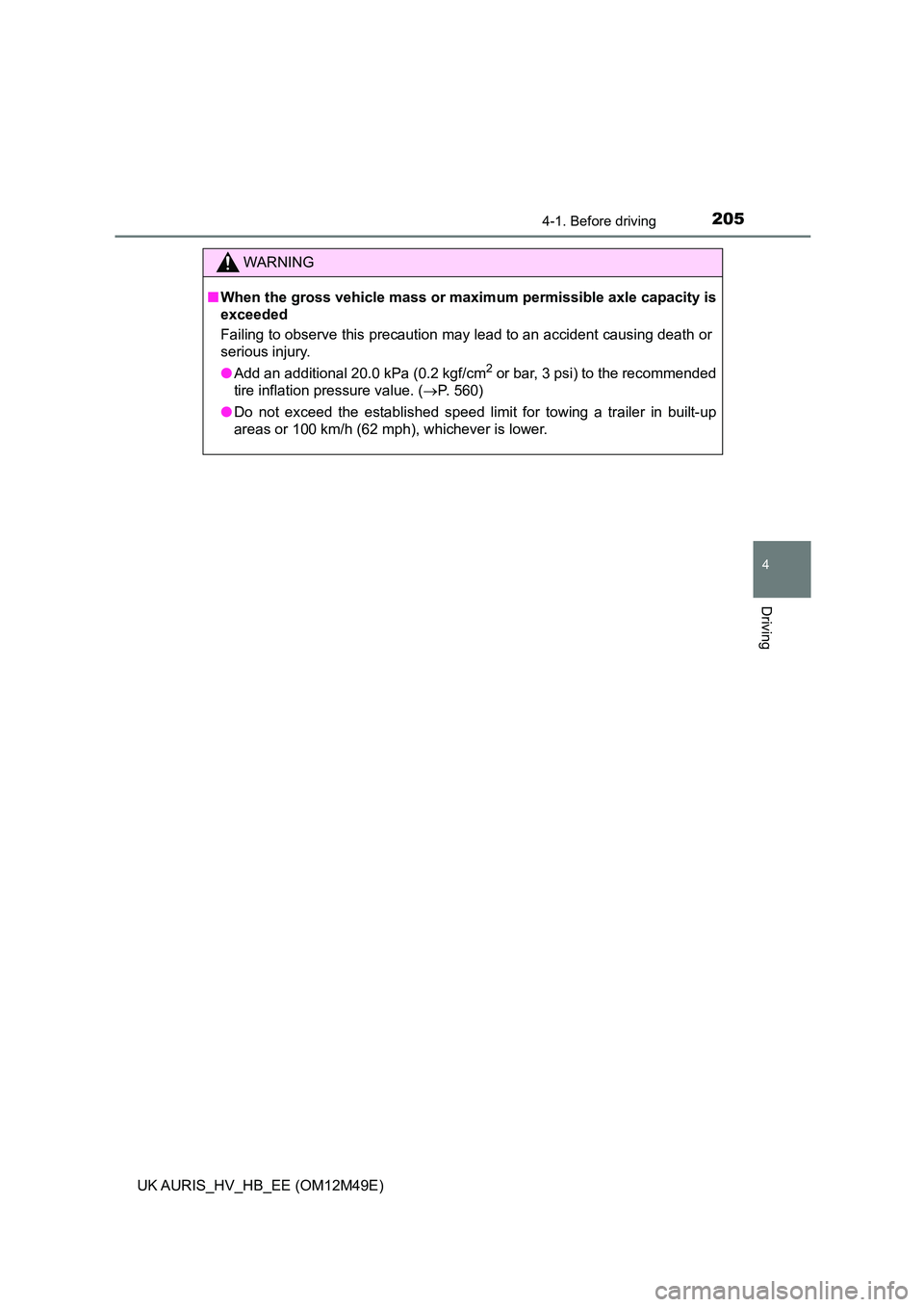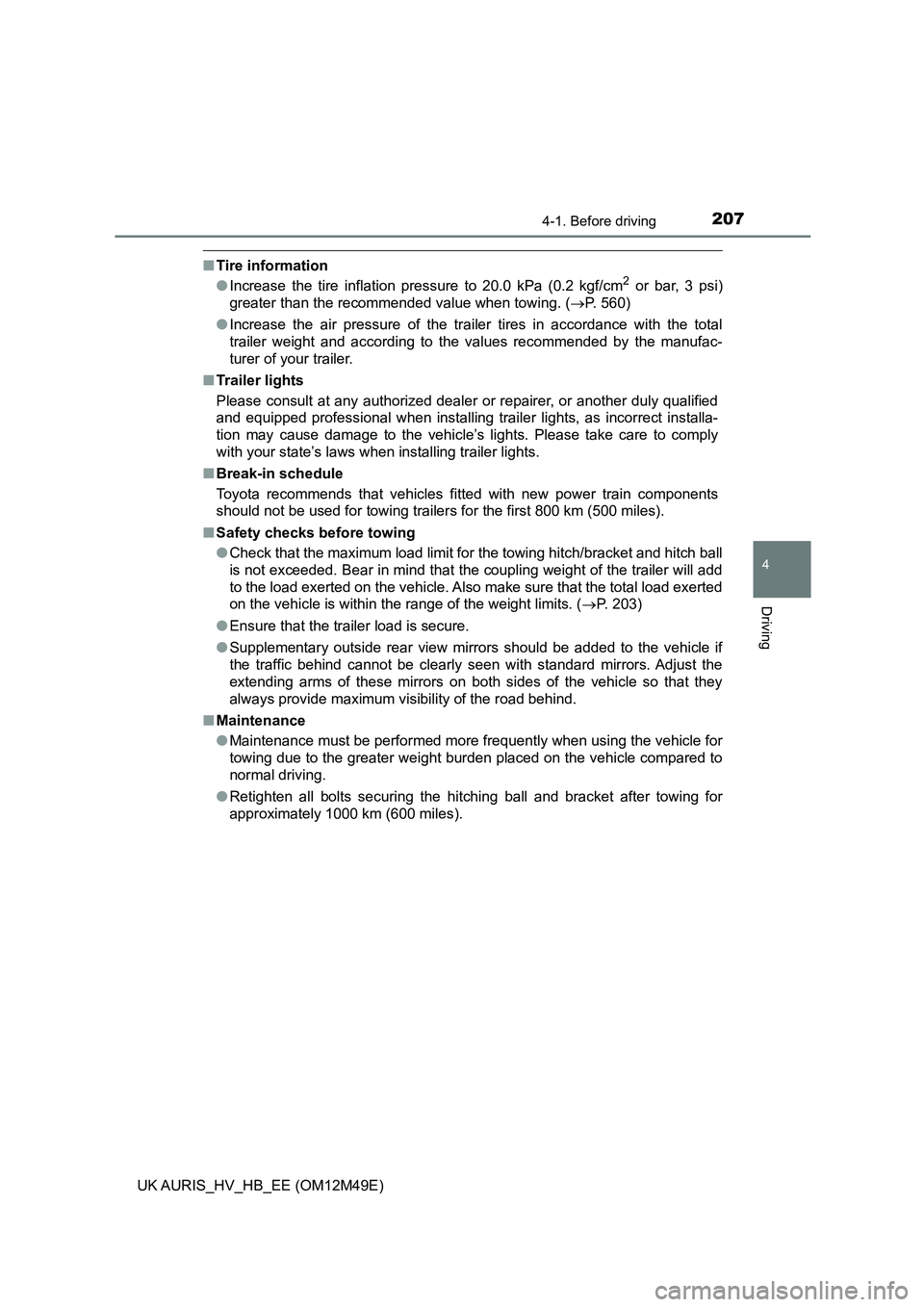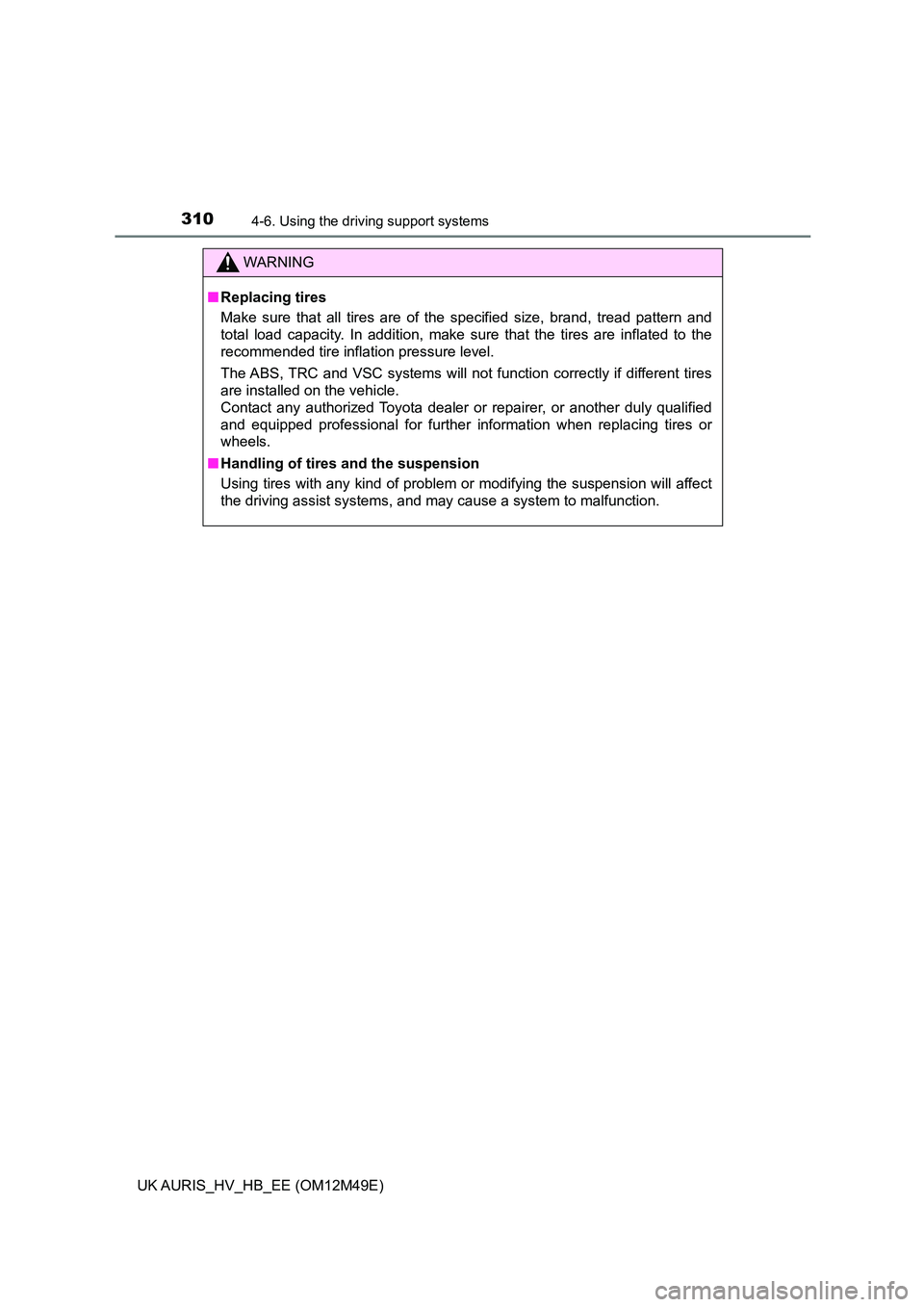2018 TOYOTA AURIS flat tire
[x] Cancel search: flat tirePage 6 of 592

TABLE OF CONTENTS6
UK AURIS_HV_HB_EE (OM12M49E)
7-1. Maintenance and care
Cleaning and protecting
the vehicle exterior ..........412
Cleaning and protecting
the vehicle interior ...........416
7-2. Maintenance
Maintenance
requirements....................419
7-3. Do-it-yourself
maintenance
Do-it-yourself service
precautions ......................422
Hood ..................................424
Positioning a floor jack .......426
Engine compartment..........427
12-volt battery ....................434
Tires ...................................439
Tire inflation pressure ........453
Wheels ...............................455
Air conditioning filter ..........457
Electronic key battery ........459
Checking and replacing
fuses ................................462
Light bulbs .........................467
8-1. Essential information
Emergency flashers .......... 482
If your vehicle has
to be stopped
in an emergency ............. 483
8-2. Steps to take
in an emergency
If your vehicle needs
to be towed ..................... 484
If you think something
is wrong........................... 490
If a warning light turns on
or a warning buzzer
sounds ............................ 491
If a warning message
is displayed ..................... 498
If you have a flat tire
(vehicles with
a spare tire) ..................... 507
If you have a flat tire
(vehicles with
an emergency tire
puncture repair kit) .......... 519
If the hybrid system will
not start ........................... 534
If the electronic key
does not operate
properly ........................... 536
If the 12-volt battery
is discharged ................... 539
If your vehicle
overheats ........................ 544
If the vehicle becomes
stuck................................ 549
7Maintenance and care8When trouble arises
Page 15 of 592

15Pictorial index
UK AURIS_HV_HB_EE (OM12M49E)
Windshield wipers . . . . . . . . . . . . . . . . . . . . . . . . . . . . . . . . . P. 237
Precautions for winter . . . . . . . . . . . . . . . . . . . . . . . . . . . . . . . P. 314
Precautions for using a car wash . . . . . . . . . . . . . . . . . . . . . . P. 414
Fuel filler door . . . . . . . . . . . . . . . . . . . . . . . . . . . . . . . . . . . . P. 243
Refueling method . . . . . . . . . . . . . . . . . . . . . . . . . . . . . . . . . . P. 243
Fuel type/fuel tank capacity . . . . . . . . . . . . . . . . . . . . . . . . . . . P. 554
Tires . . . . . . . . . . . . . . . . . . . . . . . . . . . . . . . . . . . . . . . . . . . . P. 439
Tire size/inflation pressure . . . . . . . . . . . . . . . . . . . . . . . . . . . . P. 560
Winter tires/tire chains . . . . . . . . . . . . . . . . . . . . . . . . . . . . . . . P. 314
Checking/rotation/tire pressure warning system*1 . . . . . . . . . P. 439
Coping with flat tires . . . . . . . . . . . . . . . . . . . . . . . . . . . . . . . . P. 507
Hood . . . . . . . . . . . . . . . . . . . . . . . . . . . . . . . . . . . . . . . . . . . . P. 424
Opening . . . . . . . . . . . . . . . . . . . . . . . . . . . . . . . . . . . . . . . . . . P. 424
Engine oil . . . . . . . . . . . . . . . . . . . . . . . . . . . . . . . . . . . . . . . . . P. 555
Coping with overheating . . . . . . . . . . . . . . . . . . . . . . . . . . . . . P. 544
Headlights/front position lig hts/daytime running lights/
turn signal lights . . . . . . . . . . . . . . . . . . . . . . . . . . . . . . P. 227, 229
Front fog lights*1. . . . . . . . . . . . . . . . . . . . . . . . . . . . . . . . . . P. 235
Stop lights/tail lights/turn signal lights . . . . . . . . . . . . P. 227, 229
License plate lights . . . . . . . . . . . . . . . . . . . . . . . . . . . . . . . . P. 229
Tail lights . . . . . . . . . . . . . . . . . . . . . . . . . . . . . . . . . . . . . . . . P. 229
Rear fog light*3 . . . . . . . . . . . . . . . . . . . . . . . . . . . . . . . . . . . P. 235
Back-up light*2
Shifting the shift position to R . . . . . . . . . . . . . . . . . . . . . . . . . P. 219
Tail lights . . . . . . . . . . . . . . . . . . . . . . . . . . . . . . . . . . . . . . . . P. 229
Rear fog light*2 . . . . . . . . . . . . . . . . . . . . . . . . . . . . . . . . . . . P. 235
Back-up light*3
Shifting the shift position to R . . . . . . . . . . . . . . . . . . . . . . . . . P. 219
4
5
6
7
Light bulbs of the ext erior lights for driving
(Replacing method: P. 467, Watts: P. 563)
8
9
10
11
12
13
*1: If equipped
*2: Left-hand drive vehicles
*3: Right-hand drive vehicles
Page 199 of 592

1994-1. Before driving
UK AURIS_HV_HB_EE (OM12M49E)
4
Driving
NOTICE
■If you get a flat tire while driving
A flat or damaged tire may cause the following situations. Hold the steering
wheel firmly and gradually depress the brake pedal to slow down the vehi-
cle.
● It may be difficult to control your vehicle.
● The vehicle will make abnormal sounds or vibrations.
● The vehicle will lean abnormally.
Information on what to do in case of a flat tire ( P. 507, 519)
■ When encountering flooded roads
Do not drive on a road that has flooded after heavy rain etc. Doing so may
cause the following serious damage to the vehicle:
● Engine stalling
● Short in electrical components
● Engine damage caused by water immersion
In the event that you drive on a flooded road and the vehicle is flooded, be
sure to have any authorized Toyota dealer or repairer, or another duly quali-
fied and equipped professional check the following:
● Brake function
● Changes in quantity and quality of engine oil, hybrid transmission fluid,
etc.
● Lubricant condition for the bearings and suspension joints (where possi-
ble), and the function of all joints, bearings, etc.
If the P position control system is damaged by flooding, it may not be possi-
ble to shift the shift position to P, or from P to other positions. When the shift
position cannot be changed from P to any other position, the front wheels
will lock, and you will be unable to tow the vehicle with the front wheels on
the ground, as the front wheels may be locked. In this case, transport the
vehicle with both front wheels or all four wheels lifted.
Page 205 of 592

2054-1. Before driving
UK AURIS_HV_HB_EE (OM12M49E)
4
Driving
WARNING
■When the gross vehicle mass or maximum permissible axle capacity is
exceeded
Failing to observe this precaution may lead to an accident causing death or
serious injury.
● Add an additional 20.0 kPa (0.2 kgf/cm2 or bar, 3 psi) to the recommended
tire inflation pressure value. ( P. 560)
● Do not exceed the established speed limit for towing a trailer in built-up
areas or 100 km/h (62 mph), whichever is lower.
Page 207 of 592

2074-1. Before driving
UK AURIS_HV_HB_EE (OM12M49E)
4
Driving
■Tire information
● Increase the tire inflation pressure to 20.0 kPa (0.2 kgf/cm2 or bar, 3 psi)
greater than the recommended value when towing. ( P. 560)
● Increase the air pressure of the trailer tires in accordance with the total
trailer weight and according to the values recommended by the manufac-
turer of your trailer.
■ Trailer lights
Please consult at any authorized dealer or repairer, or another duly qualified
and equipped professional when installing trailer lights, as incorrect installa-
tion may cause damage to the vehicle’s lights. Please take care to comply
with your state’s laws when installing trailer lights.
■ Break-in schedule
Toyota recommends that vehicles fitted with new power train components
should not be used for towing trailers for the first 800 km (500 miles).
■ Safety checks before towing
● Check that the maximum load limit for the towing hitch/bracket and hitch ball
is not exceeded. Bear in mind that the coupling weight of the trailer will add
to the load exerted on the vehicle. Also make sure that the total load exerted
on the vehicle is within the range of the weight limits. ( P. 203)
● Ensure that the trailer load is secure.
● Supplementary outside rear view mirrors should be added to the vehicle if
the traffic behind cannot be clearly seen with standard mirrors. Adjust the
extending arms of these mirrors on both sides of the vehicle so that they
always provide maximum visibility of the road behind.
■ Maintenance
● Maintenance must be performed more frequently when using the vehicle for
towing due to the greater weight burden placed on the vehicle compared to
normal driving.
● Retighten all bolts securing the hitching ball and bracket after towing for
approximately 1000 km (600 miles).
Page 263 of 592

2634-5. Toyota Safety Sense
UK AURIS_HV_HB_EE (OM12M49E)
4
Driving
• If the wheels are misaligned
• If a wiper blade is blocking the front sensor
• The vehicle is wobbling.
• The vehicle is being driven at extremely high speeds.
• When driving on roads with sharp bends or uneven surfaces
• When a preceding vehicle is a poor reflector of laser
● In some situations such as the following, sufficient braking force may not be
obtained, preventing the system from performing properly:
• If the braking functions cannot operate to their full extent, such as when
the brake parts are extremely cold, extremely hot, or wet
• If the vehicle is not properly maintained (brakes or tires are excessively
worn, improper tire inflation pressure, etc.)
• When the vehicle is being driven on a gravel road or other slippery sur-
face
• If your vehicle is skidding
• When the front part of the vehicle is
raised or lowered
• When the sensor is misaligned due to
a strong impact being applied to the
sensor, etc.
Page 273 of 592

2734-5. Toyota Safety Sense
UK AURIS_HV_HB_EE (OM12M49E)
4
Driving
●In the situations shown below, the system may not be able to accurately
detect surrounding brightness levels. This may cause the low beams to
remain on or the high beams to cause problems for pedestrians, vehicles
ahead or other parties. In these cases, manually switch between the high
and low beams.
• In bad weather (rain, snow, fog, sandstorms, etc.)
• The windshield is obscured by fog, mist, ice, dirt, etc.
• The windshield is cracked or damaged.
• The front sensor is deformed or dirty.
• The front sensor temperature is extremely high.
• Surrounding brightness levels are equal to those of headlights, tail lights
or fog lights.
• Vehicles ahead have headlights or tail lights that are either switched off,
dirty, are changing color, or are not aimed properly.
• When driving through an area of i ntermittently changing brightness and
darkness.
• When frequently and repeatedly driving ascending/descending roads, or
roads with rough, bumpy or uneven surfaces (such as stone-paved
roads, gravel tracks, etc.).
• When frequently and repeatedly taking curves or driving on a winding
road.
• There is a highly reflective object ahead of the vehicle, such as a sign or
a mirror.
• The back of a vehicle ahead is highly reflective, such as a container on a
truck.
• The vehicle’s headlights are damaged or dirty, or are not aimed properly.
• The vehicle is listing or titling due to a flat tire, a trailer being towed, etc.
• The high beam and low beam are repeatedly being switched between in
an abnormal manner.
• The driver believes that the high beam may be causing problems or dis-
tress to other drivers or pedestrians nearby.
Page 310 of 592

3104-6. Using the driving support systems
UK AURIS_HV_HB_EE (OM12M49E)
WARNING
■Replacing tires
Make sure that all tires are of the specified size, brand, tread pattern and
total load capacity. In addition, make sure that the tires are inflated to the
recommended tire inflation pressure level.
The ABS, TRC and VSC systems will not function correctly if different tires
are installed on the vehicle.
Contact any authorized Toyota dealer or repairer, or another duly qualified
and equipped professional for further information when replacing tires or
wheels.
■ Handling of tires and the suspension
Using tires with any kind of problem or modifying the suspension will affect
the driving assist systems, and may cause a system to malfunction.